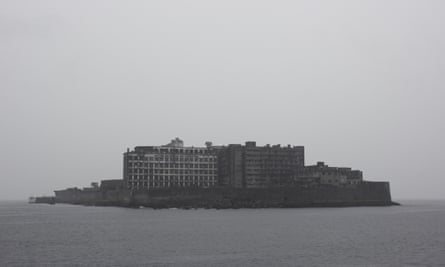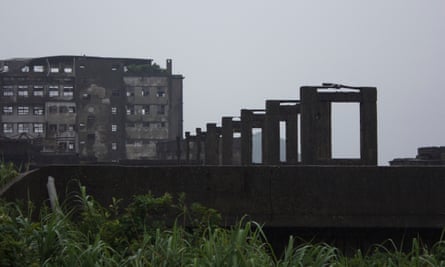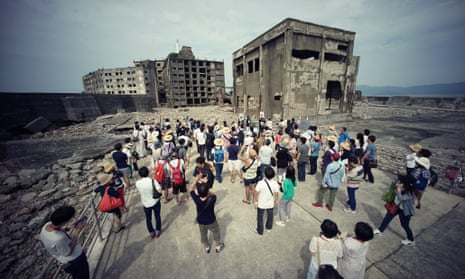The hardship is still etched on Tomoji Kobata’s face, more than half a century after he left Gunkanjima, a disused undersea coalmine at the centre of another diplomatic tussle between Japan and South Korea over their wartime legacy.
There was the time he nearly fainted during his first, stomach-churning descent into the mineshaft; the coal dust that would fall from his face into his food; and the exhaustion that would consume him when he returned every evening to his tiny flat.

“I was one of the ‘moles’,” Kobata told the Guardian during a recent visit to the island, a 30-minute boat trip from Nagasaki on Japan’s southernmost main island of Kyushu. “I mined coal and then helped break it up so that it could be taken off the island. It was backbreaking work, so I spent all of my free time sleeping.”
Despite the travails of his year on the island as a 24-year-old in the early 1960s, Kobata hopes his former home, now an open museum of crumbling buildings and industrial machinery, is made a world heritage site when Unesco officials deliberate in Bonn at the weekend.
Gunkanjima, or Battleship island – so named because of the shape of its distant silhouette – is one of 23 sites from the late 19th to early 20th centuries Japan wants recognised for their contribution to its modernisation in the decades leading up to the second world war.
But the seawalls that once protected residents from typhoons sweeping in from the East China Sea conceal a darker chapter in the island’s history.
Gunkanjima and six other sites on the Unesco list employed up to 60,000 Korean labourers who were forcibly taken to work in Japanese mines and factories towards the end of Tokyo’s 1910-45 colonial rule of the Korean peninsula.
The Unesco bid has sparked opposition from South Korea, where lingering anger over Japan’s wartime conduct is being fuelled by allegations that Japan’s conservative leader, Shinzo Abe, is attempting to sanitise his country’s past.
The bid for Unesco recognition covers the 1850s to 1910, when Japan embarked on a period of rapid industrialisation as it sought to catch up with western colonial powers.
The application makes no mention of the use of conscripted labour in the 1930s and 40s, after Japan had colonised Korea and invaded China and other parts of Asia – an omission that has also angered former British prisoners-of-war who were used as slave labour.

Mitsubishi, which developed Gunkanjima, and other wartime employers of forced labourers insist that all compensation and reparation demands were settled by postwar treaties.
As the decision in Bonn looms, officials from both countries have been locked in negotiations in an attempt to bridge the gap. Reports suggest they could strike a deal in which the South Korean government would drop its opposition in return for Japanese backing for its own heritage applications.
“They haven’t been able to agree fully yet,” an unnamed government official told South Korea’s Yonhap news agency on Friday. “The Japanese have agreed with us in principle, but the devil is in the detail.”
Reports this week said that Seoul would not block the bid, but would stress that the sites’ darkest “secrets” be clearly stated in Unesco documents.
“Rampant racism and discrimination meant Koreans were treated as second-class subjects and would have been assigned some of the hardest and most dangerous jobs,” said William Underwood, a US-based expert on forced labour in wartime Japan.
Underwood said Japan’s bid had been soured by recent moves by conservative politicians to rewrite the country’s wartime narrative by insisting, for example, that tens of thousands of mainly Korean women who worked in wartime brothels were not coerced.
“If Japan, and especially the companies involved, had been more sincere about facing up to their wartime past, then there would be no problem with highlighting” the Meiji period [1868-1912] industrial revolution, Underwood said.
“But because of the postwar avoidance of responsibility, this amazing story cannot be easily told. The regional audience is apprehensive about the intended moral behind the story.”
According to Japan, that story is one of lightning-speed industrial development that laid the foundations for the country’s modern status as an economic superpower.
Other candidate sites include shipyards and steelworks, ports, mines, industrial furnaces and docks. But of the 23 candidates, Gunkanjima has attracted the most global attention due both to its unusual location and its appearance as the lair of James Bond’s nemesis Raoul Silva in the 2012 film Skyfall.

During its heyday, the 16-acre island, whose official name is Hashima, was the most densely crowded place on earth, with more than 5,000 people, including families with young children, living in cramped high-rise apartments.
It had been uninhabited until the Mitsubishi industrial group bought the islands in the late 1800s after coal was discovered deep beneath the seabed.
Entire buildings and the paraphernalia of daily life were left to succumb to the rigours of time and the elements when Japan’s increasing dependence on imported oil forced the mine’s closure in 1974.
Whatever Unesco decides, former labourers say they will continue their campaign for compensation from the firms they claim exploited them in the 1930s and 40s.
They include 90-year-old Joo Seok-bong, one of several Koreans suing Nippon Steel & Sumitomo Metal – the Japanese firm that now owns the Yawata steel plant where he worked towards the end of the war – for unpaid wages and an apology.

“I was always starving since I received very little food,” Joo, who was put to work at the steel mill in 1943, told the Associated Press. “We were terrified of dying in bombings, but I suffered from hunger the most.”
In return for living in near-forced isolation, and in such unforgiving conditions, Gunkanjima residents were granted a few perks. Their apartments, though small, contained the latest electrical appliances, and the monthly household electricity bill came to a paltry one yen. The island had its own cinema, sports facilities, hospital, school, bathhouse and graveyard. Fresh water and electricity was supplied from the mainland, nine miles away.
“After work, most people just wanted to drink alcohol and sleep,” said Kobata, who now takes groups of tourists around parts of Gunkanjima that have been made safe with concrete reinforcements.
The 77-year-old puts the island’s chances of Unesco recognition at “fifty-fifty”.
“Life there was incredibly tough, but I wouldn’t change a thing,” he said. “It gave me an inner strength that I was able to use later on in life.
“We need to tell people around the world what life was really like there, including the part that forced labourers played. If we don’t, the place will end up being forgotten.”
